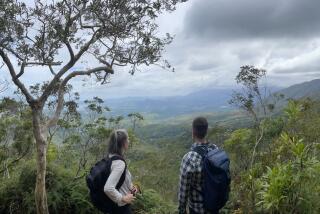Scientists sequence DNA of a âliving fossilâ: the coelacanth
Theyâre big, theyâre furtive, theyâre weird-looking. You almost certainly wouldnât want to dine on one, since theyâre endangered and are said to cause digestive distress in people who eat them.
But the African coelacanth is extremely useful in at least one way, said Jessica Alfoldi, a research scientist at the Broad Institute in Cambridge, Mass. Because it resembles ancient marine ancestors, itâs a beloved subject for biologists trying to figure out how land vertebratesâ fish forebears first climbed out from oceans, some 400 million years ago.
On Wednesday the fish became even more valuable for researchers, as Alfoldi and an international team of collaborators published a draft of the coelocanthâs genome in the journal Nature. The genome, a record of the 2.86 billion DNA letter pairs that make up the strange beastâs genetic blueprint, could help scientists answer a host of questions about land creaturesâ evolution -- for instance, how fins became limbs, or how animals developed placentas.
Assembling the genome wasnât easy, Alfoldi said. The African coelacanth is native to a small region off the coast of southern Africa, and it lurked undetected in underwater caves until 1938 when the curator of a small natural history museum spotted it in a fishermanâs catch. (In 1997, scientists discovered a second extant coelacanth species in Indonesia.)
It didnât take long after the African coelacanthâs discovery for biologists to speculate about its relationship to the ancient lobe-finned fishes that eventually evolved to become land vertebrates.
âPeople looked at these ancient fossils and they looked at the living fish and they said, âIt really looks alike,ââ said Alfoldi. âIt looked more like its fossils than we look like our ancestors from 300 million years ago.â (Our ancestors from back then looked a lot like coelacanths, she noted.)
Scientists knew that studying the coelacanthâs genes and comparing them to other vertebratesâ DNA might provide insight into the evolutionary family tree. But getting a suitable coelacanth sample for genetic sequencing took decades, Alfoldi said -- in part because the fish are âcrazily endangeredâ and catching them requires securing special permits, and in part because gene sequencing technology wasnât up to speed to decode a genome from the tiny samples the researchers had.
Finally, in the last few years, the team was able to assemble a draft sequence. In the Nature study, they reported several new insights that arose from the work. First, by comparing coelacanth DNA with that of a host of other land and sea vertebrates, the researchers saw that coelacanths have evolved more slowly than most other creatures -- a subject of interest to biologists.
The team confirmed that a type of fish called the lungfish is more closely related to tetrapods, or four-limbed vertebrates, than the coelocanth is. They also identified genetic differences between coelocanths and other vertebrates that point the way toward DNA that may have been key to the transition onto land, including sequences associated with smell, immunity and limb development.
In the future, Alfoldi said, scientists will continue to use the coelacanth genome to delve into questions about how we evolved to become the creatures we are. The lungfish may be our closer relative, but its genome, at 100 billion base pairs, is unwieldy for study.
Follow me on Twitter: @LATerynbrown







